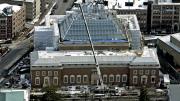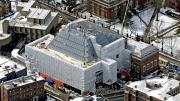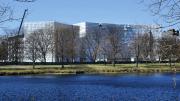The best show in Cambridge-campus construction is (sadly for gawkers, happily for art connoisseurs) entering its final act. Nothing in a sidewalk superintendent’s recent memory compares to the fiendishly complex wholesale redoing of the Fogg Art Museum into the new, three-in-one Harvard Art Museums complex, on the tightest of sites. From the removal of the Busch-Reisinger wing, on Prescott Street, to the propping up of the Fogg’s Quincy Street façade, to the excavation underneath to carve out wholly new subterranean floors, this mega-project has had it all.
Who knew that crowning the building with an enormous, angled glass bell that links the remaining old structure to the entirely new one facing Prescott would in fact present some of the best watching during the whole, multiyear spectacle? For months, workers hoisted steel frames skyward, assembling them into something whole in the air, and then fitting hundreds of panels of German glass to enclose new art study centers and the conservation lab atop the complex. From street level, the tiny figures above—in fluorescent vests, with safety harnesses and ropes, atop a ziggurat of ladders extending diagonally up the rising new roofline—have provided a constant drama of finesse and derring-do. (Crane operators, by the way, ought to be automatically certified for brain surgery or other tasks involving exquisite motor skills and split-second teamwork.)
The return of snow to New England’s winter this year (see photos)—particularly in the form of a prodigious early-February blizzard—posed challenges that the contractors had been able to avoid previously, during more clement weather. The construction tarping that wraps the superstructure protectively had to be tied down; loose materials stowed; and crane booms secured. On the Sunday following the storm, laborers shoveled off the roof to make it safe, and work resumed as normal Monday morning.
Harvard Art Museums has announced that reopening is still scheduled for the fall of next year, heralding an end to heavy construction much sooner than that.
But the University’s new frontier—in construction, as in other ways—beckons: Allston. Tata Hall, a new executive-education residence at Harvard Business School (HBS), is rising rapidly. No sooner will that job wrap up than Kresge Hall comes down (a twofer: demolition preceding construction) to make way for the successor Ruth Mulan Chu Chao Center, and then renovation of Baker Hall—resulting in expansion and modernization of the entire executive-education section of the campus. More HBS building plans (a new auditorium, a new faculty and administrative building) are already on file with Boston development authorities.
And looming larger still is the University’s fast-track plan to relocate the School of Engineering and Applied Sciences to the Allston science-complex site, just across Western Avenue. There, the enormous foundation on which work had to be suspended in 2010 awaits an ambitious research and teaching complex that will usher in the first real phase of Allston’s long-awaited academic future. (It will also play the useful role of stabilizing the foundation, which needs the counterbalancing weight of a building on top, soon.) Although the less-congested site will perhaps pose fewer logistical challenges than those the art museums’ contractors faced, it will provide more than enough reasons for hard-core amateur construction superintendents to cross the Charles—an advance guard, so to speak, for the professors and students who will be joining the HBS cohorts there later this decade.











